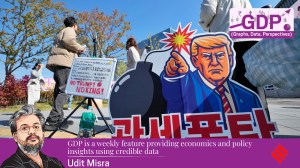Amid the ongoing Asia-Pacific Economic Cooperation (APEC) summit, the two leaders met in South Korea on Thursday (October 30). According to Trump, China has agreed to keep exports of rare earth minerals (used in a range of key global industries) flowing to the world as part of a one-year agreement. “All of the rare earth has been settled,” Trump told reporters on Air Force One. “And that’s for the world, worldwide, you could say this was a worldwide situation, not just a US situation.”

He added, “There is no roadblock at all on rare earth. That will hopefully disappear from our vocabulary for a little while.”
Story continues below this ad
Further, he said, the tariffs imposed on China as punishment for its role in the movement of the deadly opioid fentanyl to the United States would be reduced from 20% to 10%. That brings down the total US tariff rate on China from 57% to 47%.
Trump termed the meeting “amazing”, and said that on a scale of “Zero, to 10, with 10 being the best, I’d say the meeting was a 12”. What transpired, however, also highlighted some gaps, while indicating the messaging the leaders wanted to convey.
1. The first takeaway from the meeting is about its optics.
Bombast from the US President is nothing new, after eight months of Trump 2.0, and notably, there was no account from the Chinese side of the Xi-Trump meeting in the hours right after it ended.
But, importantly, the two leaders played the polite diplomatic game on the world stage, and it showed their complete awareness of the consequences of the meeting. After they entered the room where they exchanged greetings, Trump said, “We’re going to have a very successful meeting I have no doubt… But he’s a very tough negotiator that’s not good.” “We’ll have a great understanding. We’ve always had a great relationship.”
Story continues below this ad
Xi was silent, except when he initially appeared to greet Trump through a translator.
 US President Donald Trump, right, and Chinese President Xi Jinping, third left, hold their summit talk at Gimhae International Airport in Busan, South Korea, Thursday. (AP Photo/Mark Schiefelbein)
US President Donald Trump, right, and Chinese President Xi Jinping, third left, hold their summit talk at Gimhae International Airport in Busan, South Korea, Thursday. (AP Photo/Mark Schiefelbein)
The meeting lasted about one hour and forty minutes. As they left the building, the leaders seemed to be exchanging pleasantries and a handshake. Trump said something into Xi’s ear before both leaders departed.
Given how Trump’s interactions have gone with some world leaders in the past, an accommodative stance towards the Chinese President was a sign of his awareness of his limitations in dealing with the world’s second-largest economy. The fact that he couldn’t deploy his usual abrasive and bullying tactics in this situation was on full display.
In fact, he called the meeting “G-2”, borrowing from groupings like G-20 and the G-7, the latter of which constitutes some of the world’s most advanced economies. For China, the acknowledgement was a recognition of its power status. Under Xi, Beijing has been pursuing the goal of being the numero uno world power. No US President has publicly acknowledged China’s status in such terms, making it a major win for Beijing.
Story continues below this ad
Xi, too, played the part, as he praised Trump for his peace initiatives, thus borrowing from many other world leaders’ praise-heavy playbooks in dealing with Trump. He made note of two of the several wars that the US President has claimed to have brokered — the Gaza peace plan and the Thailand-Cambodia truce.
He was effusive about the US President’s enthusiasm in dealing with the “hotspots” in the world, and reminded Trump about China’s role in the Thailand-Cambodia peace pact — a subtle nod to the fact that it was Beijing’s backyard as well.
That the two leaders showed deference to each other in their own ways showed their restraint, mutual respect, and a recognition of the delicate situation at hand.
2. The second highlight was the substance of the meeting.
Trump’s account suggests that he has been able to delay the matter of China restricting its rare earths exports, which was an important concern given the chokehold China has on global supply.
Story continues below this ad
Rare earths, a group of 17 metallic elements, are used to produce magnets and other components that are a must for manufacturing everything from missiles to aircraft to cars and refrigerators. Amid the tariff tug-of-war, China had instituted limits on its exports to show the leverage it possessed, impacting global industries. So much so that NATO officials were reported complaining that the supply disruption would impact the F-35 fighter jets, and Ford was considering halting the production of cars.
In return, Trump reduced the tariffs on China by 10% — a carrot he had dangled for the Chinese businesses that were complaining and pressuring the Chinese leader to make a deal with the US President. Notably, the US is China’s largest goods export destination and the second-largest source of imports.
However, this give-and-take has merely postponed the problem of rare earth magnets, and China still holds significant dominance. For many countries, it brought home the point of managing resilient supply chains, especially when it comes to critical sectors. The world first came to notice the dependencies on China during the Covid-19 pandemic, and the leverage that Beijing had over the world’s supply chain systems. Now, the US has managed to buy more time for the world to diversify from China.
So, from that perspective, this is an important win for the US and the world, while reminding countries of the need to de-risk from China.
Story continues below this ad
3. Third, the optics and the wider message for the world.
Trump has been able to give Xi a win of sorts, but has also signalled to the world that he is not moving ahead with a complete embrace of the Chinese power status.
In pursuing the limited objective of getting the rare-earth supply chain, he has shown that this is a process of stabilising the relationship between the US and China, and not a wider reset.
The fact that Trump also had meetings with Southeast Asian leaders and, most importantly, new Japanese Prime Minister Sanae Takaichi — a protege of conservative leader Shinzo Abe and a China hawk — would have given him an insight into what to expect from Xi’s meeting.
That seemed to have worked, as the Chinese decision-making style doesn’t match Trump’s style. The Chinese system works from bottom-up negotiations, the working levels prepare the ground for the Chinese leader, and there are no last-minute surprises. Trump adapted to this and did not play his usual top-down style.
Story continues below this ad
For India, the message was clear — that the US is clearly focused on dealing with China, and Trump’s objective about managing China has not changed. What may have changed is whether he needs allies and partners to manage China, and whether he can handle China on his own. That is where the relevance of Quad grouping (constituting the US, India, Japan and Australia) is in question now.
Also, with China’s tariffs reduced to 47%, India becomes the country with the highest tariffs at 50%. This puts India at a disadvantage and would further propel negotiations for a trade deal with the US.
Trump has already said he will have a trade deal with India on his way to South Korea. But, until that is done, the fact is that a strategic partner of the US (read India) is put at a disadvantage against a strategic rival of the US (read China).



 US President Donald Trump, right, and Chinese President Xi Jinping, third left, hold their summit talk at Gimhae International Airport in Busan, South Korea, Thursday. (AP Photo/Mark Schiefelbein)
US President Donald Trump, right, and Chinese President Xi Jinping, third left, hold their summit talk at Gimhae International Airport in Busan, South Korea, Thursday. (AP Photo/Mark Schiefelbein)



































